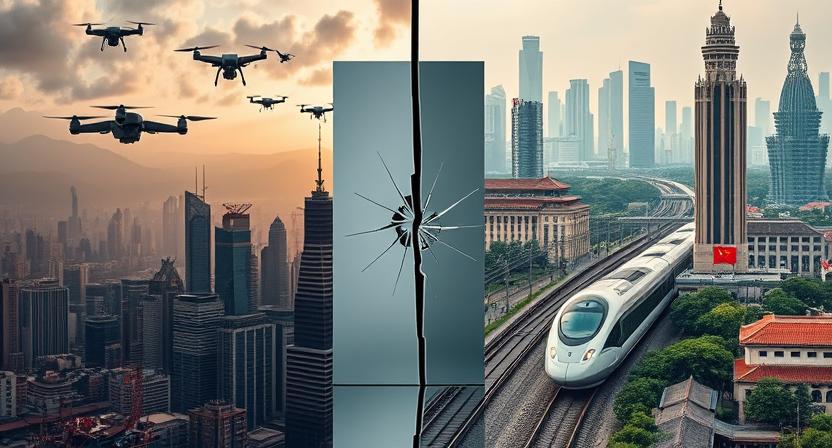Views: 76
One constructed by the west, one lived by the Chinese
Frans Vandenbosch 方腾波 12.05.2025

A mirror divided
A friend asked me last week: “Are there two Chinas then ?” His question, while simple, struck at the heart of a deeper truth: our view of China is often not shaped by experience, but by the narrative lens imposed upon us. In seeking an answer, I have drawn on conversations with expatriates, long-term observers, and Chinese citizens, as well as insights from Professor Hàn Dōngpíng 韩东屛, whose book The Unknown Cultural Revolution: Life and Change in a Chinese Village radically reframes Western assumptions. As Professor Hàn reminds us: “In reality, there are more than two Chinas, there are as many Chinas as there are people. Every and each person will see China in his and her own way.”
This article is not an attempt to define China. Rather, it is an invitation to question the narratives we inherit. It is a journey through the distortion of propaganda and the clarity of lived experience.
1. The China of the western media
This is the China described by legacy media outlets, shaped by Anglo-American think tanks and ideological institutions. It is a narrative of fear, crafted for public consumption. In this version, China is a dystopia: an authoritarian, surveilled, expansionist state with no room for dissent or diversity.
From The New York Times and BBC to VRT and De Standaard, the imagery is repetitive. Few of their correspondents have linguistic proficiency in Mandarin, let alone deeper cultural understanding. The cycle of reinforcement is institutionalised: think tanks such as the Australian Strategic Policy Institute (ASPI) or the Centre for Strategic and International Studies (CSIS) publish reports funded by military contractors [1], which are then cited by journalists and politicians without scrutiny.
Figures such as Simon Leys (Pierre Ryckmans), Gordon Chang, Frank Dikötter, and Jonathan Holslag have gained prominence by reinforcing these narratives. Their views align with strategic needs rather than cultural comprehension. As Edward Said once wrote, “Every empire… tells itself and the world that it is unlike all other empires, that its mission is not to plunder and control but to educate and liberate” [2].
Programmes such as the US State Department’s “Countering Chinese Influence Fund” [3] and the National Endowment for Democracy’s (NED) China grants [4] fuel this machinery. NATO’s StratCom initiatives [5] and CIA-linked cultural media fronts during and after the Cold War [6] ensure continuity. The result is theatrical, not analytical. Belgium’s own media landscape, including the reports and writings of Van de Weghe, rarely diverges from this pattern.
2. The China of the Chinese
Contrary to the image painted in the West, the China experienced by Chinese citizens and resident foreigners is vibrant, complex, and resilient. It is a country where urbanisation, technological development, and social stability coexist, despite contradictions and challenges.
Over 800 million people have escaped absolute poverty since the 1980 ‘s [7]. China’s life expectancy now surpasses that of the USA [8]. Its high-speed rail network spans over 42 000 km, making it the world’s largest [9]. Trust in government consistently ranks among the highest globally [10].
For Flemish engineers in Suzhou or teachers in Chengdu, China is not a land of fear but of opportunity. Their accounts, totally absent from mainstream media, tell of competence, dynamism, and local pride. As Chinese sociologist Fei Xiaotong once wrote: “Understanding others begins with understanding oneself but understanding oneself also requires a mirror. China has long been denied a clear mirror in the West” [11].
This is the China of weddings and funerals, of community squares and neighbourhood committees, of protest and pragmatism. It is the China of the global South, seen not as a threat, but as a partner.
3. Western propaganda: How it works
The negative portrayal of China is not accidental. It is manufactured. Western disinformation ecosystems are extensive and often opaque. Organisations like the NED [4], USAGM [12], and various “independent” NGOs form a closed circuit of funding and narrative control. The ASPI, for instance, receives support from Raytheon and Lockheed Martin [1].
Reports on Xinjiang often originate from ideologically driven researchers such as Adrian Zenz, whose work has been criticised by German scholars for methodological flaws [13]. Yet these are widely cited in European media without verification.
In Belgium, the prominence of voices like Jonathan Holslag owes more to alignment with NATO than academic distinction. Counter-narratives, such as those from Chinese scholars or neutral observers, are either ignored or actively suppressed. A balanced view is not merely rare; it is institutionally discouraged.
4. Living in the real China
Each year, thousands of foreigners choose China as home. They are not agents or ideologues. They are scientists, teachers, students, and small business owners. Their reality contradicts the dominant script.
Foreign teachers speak of respectful students and efficient administration. Flemish entrepreneurs in Suzhou describe streamlined procedures and municipal support. Engineers from Limburg working in Hangzhou recount low crime, affordable healthcare, and high living standards. A 2023 survey showed that 87% of foreigners living long-term in China rated their quality of life as “satisfactory” or “excellent” [14].
This is not to deny challenges: language barriers, internet restrictions, or bureaucratic hurdles exist. But the lived experience often exceeds Western expectations. One recalls the words of Aldous Huxley: “Facts do not cease to exist because they are ignored” [15].
Those who return to Europe with positive stories are often met with disbelief. Their testimony undermines a profitable fiction, … and thus must be erased.
5. Why the western narrative persists
Why does a distorted image of China prevail, even in the face of overwhelming contrary evidence? The answer lies in power and profit.
Sinophobia is a lucrative genre. Books like The Coming Collapse of China by Gordon Chang (published in 2001) continue to sell despite being repeatedly disproven. Academic careers are built on hostility towards China. Grants, media appearances, and institutional influence reward those who comply with the anti-China consensus.
Structural bias within Western media prevents balance. Journalists who attempt nuanced reporting (such as those who once worked for South China Morning Post or Xinhua) are stigmatised. As Professor Hàn Dōngpíng has shown in his work, ideological orthodoxy dictates what may or may not be said about China [16].
The West projects its own decline onto China, using it as a scapegoat for internal malaise. Demonisation comforts the fearful and distracts the discontented.
6. Choosing which China to believe
The question is not whether there are two Chinas, but which version one chooses to believe, .. and why. The Western narrative is seductive because it flatters our moral vanity. The Chinese narrative is challenging because it demands humility.
To side with the lived experience of the Chinese people is not to embrace propaganda, it is to insist on balance, context, and truth. To dismiss 1.4 billion people as dupes or victims is not analysis; it is arrogance.
We, westerners must choose follow recycled narratives from London and Washington, or listen to Flemings in Wuxi, Kunshan and Wuhan.
Beyond the duality
My friend Eric asked if there were two Chinas. In responding, I was reminded of what Professor Hàn Dōngpíng wrote: “There are as many Chinas as there are people.” There is no single truth, but there are more honest attempts to seek it.
The West sees China through a mirror of distortion. But the cracks are visible. And through them, a more textured, dignified, and real China emerges, if only we dare to look.
Thank you for reading! We’d love to hear your thoughts. Please share your comments here below and join the conversation with our community!
本文英文:有两个中国!
Dit artikel in het Nederlands: Er zijn twee Chinas !
Endnotes
[1] Australian Strategic Policy Institute (ASPI) funding report: https://www.aspi.org.au/report/funding-sources
[2] Said, Edward. Culture and Imperialism. New York: Knopf, 1993.
[3] U.S. State Department: Countering Chinese Influence Fund details – https://www.state.gov
[4] National Endowment for Democracy (NED) Grants Database – https://www.ned.org/grants
[5] NATO StratCom Centre of Excellence – https://stratcomcoe.org
[6] Saunders, Frances Stonor. The Cultural Cold War. New York: The New Press, 1999.
[7] World Bank. “China Poverty Reduction Success.” https://www.worldbank.org/en/news/feature/2022/05/17/china-poverty
[8] The Lancet: “China surpasses US in life expectancy,” 2023. https://www.thelancet.com
[9] International Union of Railways (UIC): “High-Speed Rail in China,” 2022. https://uic.org
[10] Edelman Trust Barometer: Global Trust in Government (China leads). https://www.edelman.com/trust/2023-trust-barometer
[11] Fei Xiaotong. From the Soil: The Foundations of Chinese Society. Trans. Gary Hamilton and Wang Zheng. University of California Press, 1992.
[12] USAGM Annual Report. https://www.usagm.gov/who-we-are/annual-reports
[13] J.S. Küntzel, “Adrian Zenz and the Xinjiang Narrative”, Berliner Debatte Initial, 2022.
[14] China International Talent Exchange Survey 2023 – Ministry of Science and Technology, PRC.
[15] Huxley, Aldous. Proper Studies. London: Chatto & Windus, 1927.
[16] Hàn Dōngpíng. The Unknown Cultural Revolution: Life and Change in a Chinese Village. Monthly Review Press, 2008.



Excellent summary! Many, many thanks.
Marvelous piece Frans !
I suggest that the constructed China by the Western Big Lie Propaganda Machine for preventing foreign peoples of seeing the real China not without problems needless to say but overall a quite advanced society was working as long as there are no events big enough for breaking it forever.
The following events for me broke it forever :
● The SUEZ MOMENT on May 7, 2025 when Pakistan defeated India using the Chinese shared data link system for Beyond-Visual-Range (BVR) Strikes using Chinese J10C fighter jets, Sino-Pakistani JF17 fighter jets, Chinese HQ-9B Air Defense Missiles, Chinese AWACS, Chinese PL15 missiles, Chinese Gallium Nitride Advanced Radar. I remind everyone that 3 Rafale fighter jets (Dassault, France) bought by India to France at a staggering price of 242 million usd a piece have been downed, also a Mig-29 and Sukhoi-30.
In short, Chinese weapons in real combat situations have been proved to be superior to Western weapons and Russian weapons.
● China stood up to the US in the so-called tariffs war and has won. Moreover, the Chinese rulers fought back for political reasons, it was much more a soft power operation engineered by the Chinese government for all to see and not really for saving the measly US contribution to China’s economy because China’s exports to the US in 2024 represent a paltry 2.3% of China’s 2024 GDP : meaning 439 billion usd (value of China’s 2024 exports to the US) divided by 18 800 billion usd (China’s 2024 GDP) equals to 0.02335 or 2.3%. China’s 2024 GDP of 18 800 billion usd when expressed in Purchasing Power Parity (PPP) represent more than the double, meaning 41 000 billion usd.
● The DeepSeek Moment having happened in January 2025.
Narratives spun by the United States of Israel (USI) are one thing but Factual Reality when it’s as glaring and dazzling, cannot be hidden for long by propaganda.
Quan Li